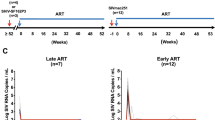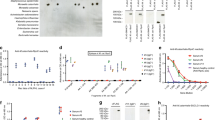Abstract
Lymphadenopathy-associated virus (LAV) is a human retrovirus first isolated1 from a homosexual patient with lymphadenopathy syndrome, frequently a prodrome or a benign form of acquired immune deficiency syndrome (AIDS)2. Other LAV isolates have subsequently been recovered from patients with AIDS or pre-AIDS3–5 and all available data are consistent with the virus being the causative agent of AIDS. The virus is propagated on activated T lymphocytes and has a tropism for the T-cell subset OKT4 (ref. 6), in which it induces a cytopathic effect. The major core protein of LAV is antigenically unrelated to other known retroviral antigens1,2,7. LAV-like viruses have more recently been independently isolated from patients with AIDS and pre-AIDS. These viruses, called human T-cell leukaemia/lymphoma virus type III (HTLV-III)8–11 and AIDS-associated retrovirus (ARV)12, seem to have many characteristics in common with LAV and probably represent independent isolates of the LAV prototype. We have sought to characterize LAV by the molecular cloning of its genome. A cloned LAV complementary DNA was used to screen a library of recombinant phages constructed from the genomic DNA of LAV-infected T lymphocytes. Two families of clones were characterized which differ in a restriction site. The viral genome is longer than any other human retroviral genome (9.1–9.2 kilobases).
This is a preview of subscription content, access via your institution
Access options
Subscribe to this journal
Receive 51 print issues and online access
$199.00 per year
only $3.90 per issue
Buy this article
- Purchase on Springer Link
- Instant access to full article PDF
Prices may be subject to local taxes which are calculated during checkout
Similar content being viewed by others
References
Barré-Sinoussi, F. et al. Science 220, 868–871 (1983).
Pinching, A. J. Clin. exp. Immun. 56, 1–13 (1984).
Montagnier, L. et al. in Human T-cell Leukemia Viruses (eds Gallo, R. C., Essex, M. & Gross, L.) 363–379 (Cold Spring Harbor, New York, 1984).
Vilmer, E. et al. Lancet ii, 753–757 (1984).
Feorino, M. P. et al. Science 225, 69–72 (1984).
Klatzmann, D. et al. Science 225, 59–63 (1984).
Kalyaranaman, V. S. et al. Science 225, 321–323 (1984).
Popovic, M., Sarngadharan, M. G., Read, E. & Gallo, R. C. Science 224, 497–500 (1984).
Gallo, R. C. et al. Science 224, 500–503 (1984).
Schüpbach, J. et al. Science 224, 503–505 (1984).
Sarngadharan, M. G., Popovic, M., Bruch, L., Schüpbach, J. & Gallo, R. C. Science 224, 506–508 (1984).
Levy, J. A. et al. Science 225, 840–842 (1984).
Montagnier, L. et al. Science 885, 63–66 (1984).
Loenen, W. A. M. & Brammar, W. J. Gene 10, 249–259 (1980).
Gallo, R. C. et al. Proc. natn. Acad. Sci. U.S.A. 79, 5680–5683 (1982).
Kalyanaraman, V. S. et al. Science 218, 571–573 (1982).
Seiki, M., Hattori, S., Hirayama, Y. & Yoshida, M. Proc. natn. Acad. Sci. U.S.A. 80, 3618–3622 (1983).
Chen, I. S. Y., McLaughlin, J., Gasson, J. C., Clark, S. C. & Golde, D. W. Nature 305, 502–505 (1983).
Shaw, G. M. et al. Proc. natn. Acad. Sci. U.S.A. 81, 4544–4548 (1984).
Gelmann, E. P., Franchini, G., Manzari, V., Wong-Staal, F. & Gallo, R. C. Proc. natn. Acad. Sci. U.S.A. 81, 993–997 (1984).
Arya, S. K. et al. Science 225, 927–930 (1984).
Harris, J. D. et al. Virology 113, 573–583 (1981).
Steele, P. E., Rabson, A. B., Bryan, T. & Martin, M. A. Science 225, 943–947 (1984).
Lenz, J. et al. Nature 308, 467–470 (1984).
Chen, I. S. Y., McLaughlin, J. & Golde, D. W. Nature 309, 276–279 (1984).
Gubler, U. & Hoffman, B. J. Gene 25, 263–269 (1983).
Grunstein, M. & Hogness, D. Proc. natn. Acad. Sci. U.S.A. 72, 3961–3965 (1975).
Sanger, F., Nicklen, S. & Coulsen, A. R. Proc. natn. Acad. Sci. U.S.A. 79, 5463–5476 (1977).
Ish-Horowicz, D. & Burke, J. F. Nucleic Acids Res. 9, 2989–2998 (1981).
Benton, W. D. & Davis, R. W. Science 196, 180–182 (1977).
Author information
Authors and Affiliations
Rights and permissions
About this article
Cite this article
Alizon, M., Sonigo, P., Barré-Sinoussi, F. et al. Molecular cloning of lymphadenopathy-associated virus. Nature 312, 757–760 (1984). https://doi.org/10.1038/312757a0
Received:
Accepted:
Issue Date:
DOI: https://doi.org/10.1038/312757a0
This article is cited by
-
Past, present and future: 30 years of HIV research
Nature Reviews Microbiology (2013)
-
The early years of HIV research: integrating clinical and basic research
Nature Medicine (2003)
-
Amplification and detection of a single molecule of human immunodeficiency virus RNA
Virus Genes (1993)
-
Discrepancies in AIDS virus data
Nature (1991)
-
The chronology of AIDS research
Nature (1987)
Comments
By submitting a comment you agree to abide by our Terms and Community Guidelines. If you find something abusive or that does not comply with our terms or guidelines please flag it as inappropriate.



